 |
||
|
||
| ||
 There is good news for those who like Canon and photography and prefer good compact (not reflex) full-featured cameras. G2 in the G3's shape has become even better. This class (not just Canon) - a compact rangefinder camera with a moderate (and therefore high-quality) zoom, auto and manual shooting settings - includes digital classic cameras. That is why it's popular and the latest models have much more common features with the ancestors than differences. I used to the G2, but some features of the G3 make it look more advantageous. Its strongest point is a dial control instead of the buttons. The other companies turned to such approach much earlier, but now Canon has caught up. The Canon PowerShot G3 extends the series of G1-G2, as well as forms
its own line. It covers IxusV3, S45 and Ds1. The new line uses a high-performance
processor DIGIC (DIGITAL IMAGING CORE). In fact, one DIGIC chip controls
the whole cycle of creating a digital image: reads data from CCD, sample
them, record into the buffer, processes image and compresses into JPEG,
controls operation of a CF card and display, auto exposure systems, focusing
and white balance (metering for auto white balance covers several thousands
of pixels). Such approach of the whole cycle in one chip speeds up operation
and cuts down power consumption. In case of the series shooting the fast
data processing at the buffer's output allows for a twice greater number
of frames in the quick series (until the buffer is full). The G3 can have
up to 14 shots in the series of 2.5 fps or 1.5 fps. The processor is optimized
for operation with images and brings in less noise than it was in the older
models. The automatic system of shooting settings now includes the iSAPS
algorithm - intelligent Scene Analysis based on PhotoSpace. The data base
making the space is a huge number of shots with different zoom factors,
image orientation, lighting and distribution of brightness. In the auto
mode the iSAPS will help you choose the correct exposure, adjust white
balance for a certain scene and speed up the auto focus. However, the G3
(G2/G1) is the camera mostly for those who used to work in manual and priority
modes. Beside the iSAPS in the G3 (and S45) you can choose any point for
focusing and exposure metering (FlexiZone AF/AE) instead of 3-point system
on the old models. And here are really important characteristics: 4X zoom,
side sensor of IR remote control, two user suites of settings, shooting
in intervals, integrated neutral filter (approximately for three steps).
And less important ones: welcome messages with sound and image, focus lock,
image auto rotation (on/off). The G3 supports Exif 2.2, direct printing
on CP10/100, S820D/830D/530D. The camera is less streamlined and more convenient.
Now let's see how the G2 and G3 perform. Control and Design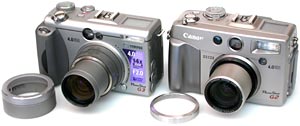 G3 and G2 The G3 has a shape similar both to the G1 and G2. The angular design adds more style and comfort. The nonstandard thread for the adapter for optical systems is replaced with even more peculiar bayonet connection. But I'm glad that the other end of the adapter has 58 mm. The adapter will probably have a madder price compared to the plastic one of the G2. But taking into account that the joint is plastic as well, it makes no sense to expect something more solid. 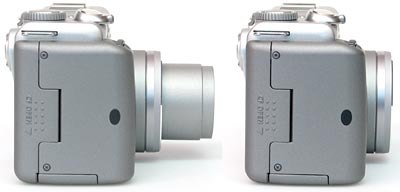 Side view at G3. IR sensor. The flash is smaller, and the IR sensor is shifted to the right side and now the remote control (the same as the G2 has) works from the front sector as well as a normal remote control.  G3 and G2 The tripod mount of the G3 is shifted to the camera's center, but not to the center of gravity; the battery compartment lock is removed. 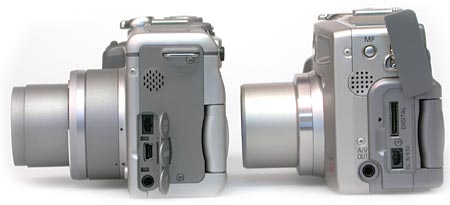 G3 and G2. The USB port is closer to the standard one. The design of the covers of the interface unit is different. The manual focusing button is now where the spot exposure metering button used to be - on the rear panel. 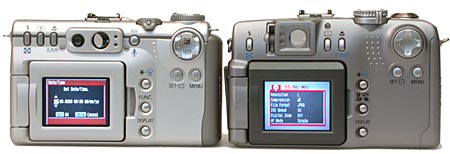 G3 and G2. The controls on the back are arranged differently and changed their functions. The multi-selector can quickly switch to the white balance adjustment and exposure correction as it has less functions thanks to the control dial. 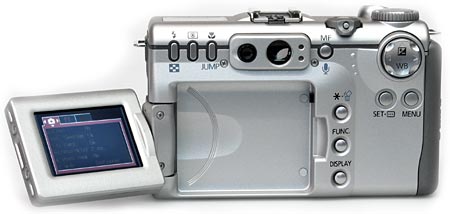 The turning display is convenient but it doesn't display shooting parameters when facing the object. 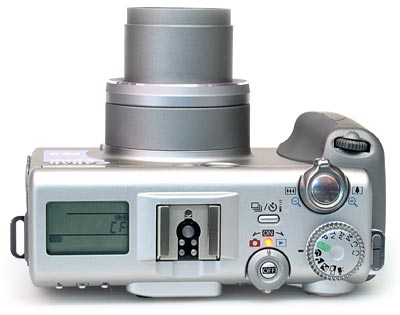 The mode dial and the switch lever are now separated, the on/off switch is in the form of a button. The switch lever has a lock (the G2 used to turn on when fished out or put in in a tight pocket). And the main peculiarity is a selector for professional control meant for the forefinger of the right hand. 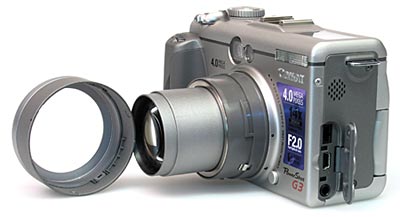 The bayonet lock button is arranged for removing the bayonet cover and attaching the adapter. Shooting menuThe menu is based on the G2's one. It has a two-level resolution and file compression mode (once you set the solution you should press "*" to go to the compression menu) and two manual white balance settings.
In the manual exposure mode and in the priorities you can enable or disable flash control in the menu. The camera works via a standard shoe with external flashes and supports only E-TTL made exceptionally by Canon (like in case of G2). The Sigma Super 500 flashes work with the camera only in the manual modes. If you disable the flash control in the menu, the aperture and zoom values won't be transferred into the flash, and if you enable it the flash will work half-automatically - i.e. it requires that you set an impulse power divider displaying the distance to the object (like in the G2). Comparison of the optical systems.The G3's lens is 7.2 (W) - 28.8 (T) mm (35mm 35 - 140 mm) F2.0 (W) - F3.0
(T), the G2's lens is 7 (W) - 21 (T) mm (35mm 34 - 102 mm)
We'll estimate the optical systems with the Levels program of Dmitry
Kuznetsov on the shot of the circular resolution chart on the edge
for the G2 and G3.
The difference is almost intangible. 4X zoom doesn't yield to 3X. In the auto
exposure mode the difference in the exposure values for G3 and G2 was about 1
step when shooting the resolution chart, but the fact that the fragments are almost
identical in brightness in case of manual setting of exposure parameters shows
that the error is both in the metering and algorithms.
At ISO 400 the cameras demonstrate equal noise levels, but at ISO 100 the G3 has a more noisy picture because of rare bright "holes" of the image. You can notice them on the fragments for ISO 50 zoomed in by 200%. The promised noise elimination is lacking. But I hope it's better in other samples. The G3 makes shots quicker than the G2. About G2: in case of the series shooting "H" without displaying each frame the buffer records 3 - 4 frames in series (JPEG 2272*1704, superior quality, 1.5 MB). Usually at short exposures 3 shots are taken at less than 2 seconds, at long exposures (for example, 1/8) - 4 shots (2 in series, 1 sec pause and 2 more in series) at 3 sec. After that 1 shot is taken during 3 - 5 sec. It also works for the G3 (JPEG 2272*1704, superior quality, 2.2 MB) - 8 shots at 3 sec and then 3-5 sec intervals. Canon PowerShot G3 Specification
Photos
Write a comment below. No registration needed!
|
Platform · Video · Multimedia · Mobile · Other || About us & Privacy policy · Twitter · Facebook Copyright © Byrds Research & Publishing, Ltd., 1997–2011. All rights reserved. | |||||||||||||||||||||||||||||||||||||||||||||||||||||||||||||||||||||||||||||||||||||||||||||